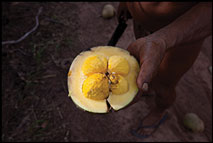Crossref Citations
This article has been cited by the following publications. This list is generated based on data provided by
Crossref.
Capriles, José M.
Lombardo, Umberto
Maley, Blaine
Zuna, Carlos
Veit, Heinz
and
Kennett, Douglas J.
2019.
Persistent Early to Middle Holocene tropical foraging in southwestern Amazonia.
Science Advances,
Vol. 5,
Issue. 4,
Neves, Eduardo G.
and
Heckenberger, Michael J.
2019.
The Call of the Wild: Rethinking Food Production in Ancient Amazonia.
Annual Review of Anthropology,
Vol. 48,
Issue. 1,
p.
371.
Shock, Myrtle Pearl
and
Moraes, Claide de Paula
2019.
A floresta é o domus: a importância das evidências arqueobotânicas e arqueológicas das ocupações humanas amazônicas na transição Pleistoceno/Holoceno.
Boletim do Museu Paraense Emílio Goeldi. Ciências Humanas,
Vol. 14,
Issue. 2,
p.
263.
Witcher, Robert
2019.
Editorial.
Antiquity,
Vol. 93,
Issue. 368,
p.
287.
Costa, Luiz
and
Fausto, Carlos
2019.
The Enemy, the Unwilling Guest and the Jaguar Host.
L'Homme,
p.
195.
Colonese, Andre Carlo
Winter, Rachel
Brandi, Rafael
Fossile, Thiago
Fernandes, Ricardo
Soncin, Silvia
McGrath, Krista
Von Tersch, Matthew
and
Bandeira, Arkley Marques
2020.
Stable isotope evidence for dietary diversification in the pre-Columbian Amazon.
Scientific Reports,
Vol. 10,
Issue. 1,
Kater, Thiago
2020.
A temporalidade das ocupações ceramistas no sítio Teotônio.
Boletim do Museu Paraense Emílio Goeldi. Ciências Humanas,
Vol. 15,
Issue. 2,
Watling, Jennifer
Almeida, Fernando
Kater, Thiago
Zuse, Silvana
Shock, Myrtle Pearl
Mongeló, Guilherme
Bespalez, Eduardo
Santi, Juliana Rossato
and
Neves, Eduardo Góes
2020.
Arqueobotânica de ocupações ceramistas na Cachoeira do Teotônio.
Boletim do Museu Paraense Emílio Goeldi. Ciências Humanas,
Vol. 15,
Issue. 2,
Iriarte, Jose
Elliott, Sarah
Maezumi, S. Yoshi
Alves, Daiana
Gonda, Regina
Robinson, Mark
Gregorio de Souza, Jonas
Watling, Jennifer
and
Handley, Josephine
2020.
The origins of Amazonian landscapes: Plant cultivation, domestication and the spread of food production in tropical South America.
Quaternary Science Reviews,
Vol. 248,
Issue. ,
p.
106582.
Mongeló, Guilherme
2020.
Ocupações humanas do Holoceno inicial e médio no sudoeste amazônico.
Boletim do Museu Paraense Emílio Goeldi. Ciências Humanas,
Vol. 15,
Issue. 2,
Gregorio de Souza, Jonas
Alcaina Mateos, Jonas
Madella, Marco
and
Biehl, Peter F.
2020.
Archaeological expansions in tropical South America during the late Holocene: Assessing the role of demic diffusion.
PLOS ONE,
Vol. 15,
Issue. 4,
p.
e0232367.
Fausto, Carlos
and
Costa, Luiz
2021.
Afinidades e diferenças: Algumas considerações sobre a política da consideração (Parte 1).
Mana,
Vol. 27,
Issue. 3,
Clement, Charles R.
Casas, Alejandro
Parra-Rondinel, Fabiola Alexandra
Levis, Carolina
Peroni, Nivaldo
Hanazaki, Natalia
Cortés-Zárraga, Laura
Rangel-Landa, Selene
Alves, Rubana Palhares
Ferreira, Maria Julia
Cassino, Mariana Franco
Coelho, Sara Deambrozi
Cruz-Soriano, Aldo
Pancorbo-Olivera, Marggiori
Blancas, José
Martínez-Ballesté, Andrea
Lemes, Gustavo
Lotero-Velásquez, Elisa
Bertin, Vinicius Mutti
and
Mazzochini, Guilherme Gerhardt
2021.
Disentangling Domestication from Food Production Systems in the Neotropics.
Quaternary,
Vol. 4,
Issue. 1,
p.
4.
Carney, Molly
Tushingham, Shannon
McLaughlin, Tara
and
d'Alpoim Guedes, Jade
2021.
Harvesting strategies as evidence for 4000 years of camas (
Camassia quamash
) management in the North American Columbia Plateau
.
Royal Society Open Science,
Vol. 8,
Issue. 4,
Furquim, Laura P.
Watling, Jennifer
Hilbert, Lautaro M.
Shock, Myrtle P.
Prestes-Carneiro, Gabriela
Calo, Cristina Marilin
Py-Daniel, Anne R.
Brandão, Kelly
Pugliese, Francisco
Zimpel, Carlos Augusto
da Silva, Carlos Augusto
and
Neves, Eduardo G.
2021.
Facing Change through Diversity: Resilience and Diversification of Plant Management Strategies during the Mid to Late Holocene Transition at the Monte Castelo Shellmound, SW Amazonia.
Quaternary,
Vol. 4,
Issue. 1,
p.
8.
de Souza, Jonas Gregorio
and
Riris, Philip
2021.
Delayed demographic transition following the adoption of cultivated plants in the eastern La Plata Basin and Atlantic coast, South America.
Journal of Archaeological Science,
Vol. 125,
Issue. ,
p.
105293.
Santos, Gilton Mendes dos
Cangussu, Daniel
Furquim, Laura Pereira
Watling, Jennifer
and
Neves, Eduardo Góes
2021.
Pão-de-índio e massas vegetais: elos entre passado e presente na Amazônia indígena.
Boletim do Museu Paraense Emílio Goeldi. Ciências Humanas,
Vol. 16,
Issue. 1,
Cagnato, Clarissa
2021.
GATHERING AND SOWING ACROSS THE CENTRAL MAYA LOWLANDS: A REVIEW OF PLANT USE BY PRECERAMIC PEOPLES AND THE EARLY TO MIDDLE PRECLASSIC MAYA.
Ancient Mesoamerica,
Vol. 32,
Issue. 3,
p.
486.
Prestes-Carneiro, Gabriela
Sá Leitão Barboza, Roberta
Sá Leitão Barboza, Myrian
Moraes, Claide de Paula
and
Béarez, Philippe
2021.
Waterscapes domestication: an alternative approach for interactions among humans, animals, and aquatic environments in Amazonia across time.
Animal Frontiers,
Vol. 11,
Issue. 3,
p.
92.
Leitão-Barboza, Myrian Sá
Kawa, Nicholas C.
Junqueira, André B.
and
Oyuela-Caycedo, Augusto
2021.
Open air laboratories: Amazonian home gardens as sites of experimentation, collaboration, and negotiation across time.
Journal of Anthropological Archaeology,
Vol. 62,
Issue. ,
p.
101302.



